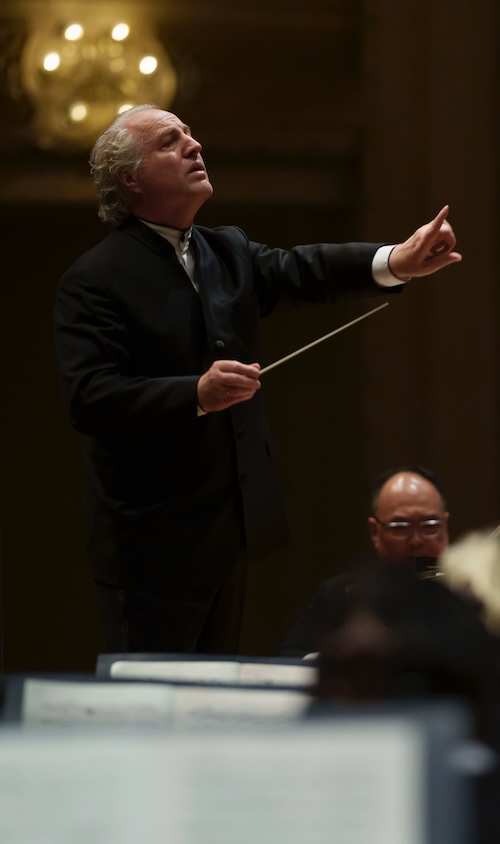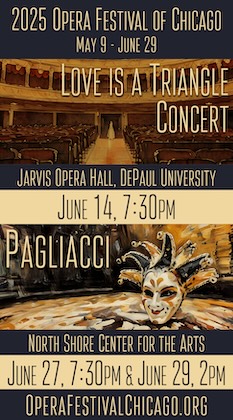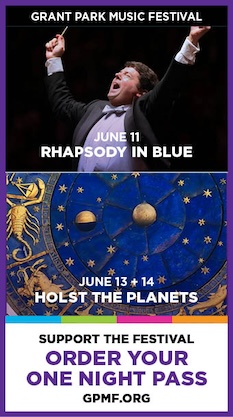Worlds collide at CSO, with percussion premiere and moving Bruckner

The competing exigencies of program scheduling can make for strange bedfellows. Such was the case with the Chicago Symphony Orchestra concert led by Manfred Honeck Thursday night, as a new percussion concerto served as prelude to a Bruckner symphony.
Written for principal percussionist Cynthia Yeh, Jessie Montgomery’s Procession opened the evening. A percussion concerto in all but name, the 25-minute work is the third CSO commission and final fruit of Montgomery’s three-year term as CSO composer in residence. Thursday’s world premiere followed Montgomery’s Hymn for Everyone in 2022 and Transfigure to Grace last year, both led by Riccardo Muti.
Procession was inspired, says Montgomery, by “the idea of how people organize and participate in variations of processionals—whether religious, political, celebratory, in marking achievements, births, deaths, war and fights for freedom… “
“We create these rituals of synchronized movement and chant to signify change, or a desire to do so… Pride is validated and catharsis set in motion by a steady marching and unwavering calls and shouts. I wanted to capture aspects of that steadiness and relentlessness.”
Unlike the usual bestiary of colorful instruments that most composers field for percussion concertos, Montgomery’s scoring for the soloist is circumscribed: marching bass drum with tom-toms plus vibraphone and glockenspiel at the front of the stage with a full drum kit upstage left.
Procession opens with drumming over a threnody-like rising theme for cellos and English horn. There is an attractive theme for strings in the first movement as well as engaging motifs elsewhere in the concerto. But the soloist’s “relentless” loud drumming repeatedly drowns out these lyrical passages. Apparently, this is not maladroit scoring but intentional, with Montgomery’s note approvingly citing “the sheer sonic power [percussion] has to override the orchestra.”
The problem is when intriguing music in the orchestra is repeatedly buried by the ceaseless drumming, the result is both frustrating and not very musical, whatever its symbolic import. The solo writing largely centers on unvaried drumwork for the duration of the five brief movements, Yeh walking back and forth between the two kits. With the nearly nonstop drumming, one was taken back to memories of youthful rock concerts in which the inevitable breakout drum solo went on forever and one pondered whether there was time enough to go out, grab a beer and return before it finished.
The most arresting moment in Procession comes about halfway through with an extended glockenspiel cadenza with vibraphone grace notes. Here Yeh conjured a haunting array of celestial sounds in a magical shimmering impressionism with tonal sensitivity and a widely terraced dynamic range–even if this seemingly semi-improvised solo went on too long.
There is an odd section where the piccolo and flute players get up and stand next to Yeh at her drum kit as they morph into a kind of fife-and-drum trio in what feels like a sardonic burlesque of colonial American music and/or the famous piccolo solo in Sousa’s Stars and Stripes Forever.
Montgomery is a talented composer as shown in previous works written for CSO and other ensembles. But Procession is not one of her more successful efforts, undermined by unvaried and repetitious solo writing, pallid scoring and less-than-compelling musical material.
Cynthia Yeh was an athletic and energetic solo protagonist in this premiere, doing all that the score asks of her. Honeck and the orchestra gave their colleague exemplary support, and soloist, composer and conductor were warmly applauded by the audience.
For the second week in a row, the principal work at 220 S. Michigan was a vast Austrian symphony. Last week it was Mahler’s “Resurrection” and Thursday it was Bruckner’s Symphony No 7.

Manfred Honeck is one of the orchestra’s most consistently reliable podium guests, often at his best in cornerstone Austro-German repertory and so it proved again Thursday night.
The brass playing was not immaculate—principal trumpet Esteban Batallán was having a rare off night and there were passing horn lapses as well. Yet, even with the fluffs, this was a dramatic, organic and often, surprisingly moving account of Bruckner’s most popular symphony.
Honeck unfolded the 64-minute work in a natural, seamless way that never played to the galleries, patiently building the arc of each movement as well as scaling them within the broader architecture. There was a direct through-line across each of the four movements. The opening Allegro moderato emerged lean and tensile; yet, despite the acute concentration, there was also charm in the airy, dancey quality of the second theme, and nuance, as in the calibrated dynamics of the final section.
In the vast Adagio, Honeck conveyed the elegiac essence of the music—wonderful sepulchral eloquence from the four Wagner tubas led by Daniel Gingrich. The conductor and players brought out a consolatory warmth and human quality, as in the contrasting theme, and built the climax inexorably to the cymbals-and-triangle climax.
The Scherzo went with spirited dash in its hunting-horn motif. The strings, excellent throughout the performance, were gleaming and notably nimble with tight ensemble. In the finale, Honeck underlined the quirky, Haydnesque quality of the main theme, building the movement steadily to the concluding section with the brass chorales and nine horns (including the Wagner tubas) reaching the double bar in blazing and sonorous fashion.
The program will be repeated 1:30 p.m. Friday and 7:30 p.m. Saturday. cso.org
Posted in Performances


Posted May 31, 2024 at 4:33 pm by david m novak
A Bruckner devotee for almost six decades, I had never wept during a performance of his work. That changed Friday. The first and second movements brought tears to my eyes. This was sublimity.
And let me be among the first to give notice: if his pedestrian Shostakovich 10 is any indication, I fear that Chicago’s new heartthrob music director will need more years than he has left on this earth to achieve the musical understanding and conductorial skills Honeck brought to Orchestra Hall. The orchestra itself was at the top of its game. I’ve never heard the strings play with such beauty.
If you can go Saturday, do so. There will be nothing better tomorrow anywhere on the planet. Wow!
David M. Novak
Posted May 31, 2024 at 8:36 pm by Jeff R
The Bruckner was wonderful.
I’m glad Jessie Montgomery’s tenure is up. Procession was unlistenable. What a mess. Yeh is an excellent percussionist but the drums drowned out everything else.
Posted Jun 01, 2024 at 1:39 pm by Peter DG
Sorry to have to say this but at the Friday performance the sublime music of Bruckner can’t survive the noisy matinee audience with its constant wrapper rustling, and occasional noisy snoozing, comments and cell phone rings. We attend some of the matinees because of the local Chicago crime scene, but we may have to rethink that.
By the way, my take on Montgomery’s music is that it is a valid attempt at development in the symphonic music genre. I had a hard time following the sequence of her thematic ideas. Maybe hearing the piece a few times would help. Maybe it needs some adjustment in instrumentation and dynamics.
Posted Jun 01, 2024 at 11:23 pm by Eric F.
The Saturday performance of Procession received a well deserved standing ovation. Yeh’s performance was top notch and, yes, the percussion was louder than the orchestra because it was basically a percussion concerto. The solo instrument is the center of attention in any concerto
Posted Jun 02, 2024 at 1:12 pm by Charles Amenta
For the Saturday performance, the CSO and Honeck were at the top of their game with only he slightest of trumpet smudges — which just confirms that we were hearing live music and not a recording. The brass were astonishing, but beyond all the magnificence was the feeling in the quiet moments with solo work by the woodwinds. I was never so moved by the pity and the sorrow of the coda to the Adagio.
I wished I could have heard more of the orchestra in the “Procession.” This seemed more of a percussion vs orchestra presentation rather than a Concerto for Percussion and Orchestra. Maybe there was a implicit scenario that the African drumming overwhelms the more urban jazzy and classical elements. This is like the Nielsen Symphony No. 5 but here the percussion “wins.”
I did very much enjoyed the quiet solo cadenza with the vibraphone notes interacting with the glockenspiel where Ms. Yeh was outstanding.
Posted Jun 02, 2024 at 4:53 pm by Todd
Montgomery’s Procession was a Pulitzer prize worthy, subversive critique and deconstruction of orchestras and their music (and maybe their audiences!). The percussion soloist represents populism and realism pounding on the streets outside of symphony center, at odds with and overwhelming the lush symphony. Eventually this throws the orchestra into disarray and initiates a fascinating interaction of both elements influencing each other. Populist movements are embodied by the soloist through elements from marching bands, jazz, and conga. It’s a fascinating interrogation of social, political, and cultural movements interacting with governments and institutions.
Procession should become a signature CSO piece that needs to be heard live and requires multiple listenings to fully appreciate and unravel.
Posted Jun 04, 2024 at 9:50 am by Andrew Edlin
First saw Bruckner 7 in 1970 under Reginald Goodall at the Proms. One review today mentioned the word ‘whimsical’. Bruckner?! Yes! Downright mischievous in places. Bravo for Herr Honeck in seeing this in the score, and bringing it out. I especially liked the anticipatory pause before the coda. From deepest sadness to quirky finesse… what an emotional and compositional range! What a misunderstood and underestimated personality.
BTW the Third is the youthful antecedent of the Seventh. It has taken me 54 years to see that. Thank you, sir!